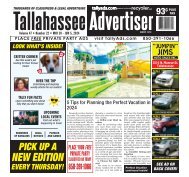Create successful ePaper yourself
Turn your PDF publications into a flip-book with our unique Google optimized e-Paper software.
THETRUCKER.COM EQUIPMENT & TECH<br />
OCTOBER 2023 • 21<br />
FLEET FOCUS<br />
Keeping equipment in tip-top shape<br />
is key to passing DOT inspection<br />
CLIFF ABBO<strong>TT</strong> | SPECIAL CORRESPONDENT<br />
Getting selected for a DOT (Department<br />
of Transportation) inspection is a lot like going<br />
to the dentist. Nobody looks forward to<br />
the occurrence. The best you can hope for is<br />
that nothing bad (or expensive) is discovered.<br />
There’s another similarity to that dentist<br />
visit, too. All too often, the painful results<br />
could have been prevented by the owner, if<br />
sensible precautions had been taken.<br />
The reality of a DOT inspection is that<br />
nothing is inspected that shouldn’t be regularly<br />
inspected by the driver.<br />
All too often, however, drivers receive<br />
citations for simple violations like air leaks,<br />
chafed hoses or inadequate tire tread. These<br />
items are easy to find and fix but often go unnoticed<br />
until pointed out by an inspector.<br />
Thanks to the PSP (Pre-Employment<br />
Screening Program) administered by the<br />
Federal Motor Carrier Safety Administration<br />
(FMCSA), violations noted during an inspection<br />
can be recorded on the driver’s PSP report.<br />
This report is ordered by prospective<br />
employers when considering a driver’s application.<br />
Each carrier uses the data in different<br />
ways, but if there’s a pattern that shows the<br />
driver doesn’t routinely inspect equipment, it<br />
could impact the company’s decision to hire<br />
the driver.<br />
Then, there’s the CSA (Compliance, Safety,<br />
Accountability) program. If you own your<br />
own trucking business, your CSA score can<br />
impact your ability to lease with other carriers<br />
or do business with customers or brokers.<br />
Still, the biggest impact of a DOT inspection<br />
may be the time lost to the inspection<br />
itself and making repairs, especially if those<br />
repairs are to correct an out-of-service (OOS)<br />
violation.<br />
Waiting for a service truck to arrive and<br />
replace a tire, for example, means absorbing<br />
the cost of the service call AND the potential<br />
revenue lost if your load can’t be delivered<br />
on time. Losing a day to wait for another appointment<br />
can cost more than the service<br />
call.<br />
The DOT lists eight levels of inspection,<br />
but most drivers need only be concerned<br />
with the first three.<br />
A Level III inspection, the most common<br />
type, examines a driver’s credentials. It seems<br />
obvious that a driver should have a valid CDL<br />
for the vehicle driven, along with medical<br />
certification card when required, but drivers<br />
are often cited for missing these. Level III<br />
inspections usually include a review of the<br />
record of duty status and verify that the carrier<br />
is properly identified. Inspectors often<br />
observe seatbelt use as well.<br />
A Level II inspection includes those items<br />
in Level III plus a walk-around check of the<br />
equipment for obvious violations. Inspectors<br />
may look at lights, listen for air leaks and<br />
check for poor cargo securement, missing lug<br />
nuts and other items that are easy to identify.<br />
Level I is a full-blown inspection, where<br />
brakes, steering and other components are<br />
checked for wear and damage — along with<br />
everything included in Levels II and III.<br />
The first step in passing a DOT inspection<br />
is to not get inspected.<br />
While inspectors sometimes choose<br />
trucks to inspect at random, they often<br />
choose based on their observation of trucks<br />
in the area. Trucks with obvious issues, such<br />
as a burned-out headlight, are prime targets.<br />
Trucks that have papers and trash all over<br />
the dash and visible through the windshield<br />
are practically volunteering for inspection.<br />
Sometimes, inspections are the aftermath of<br />
a traffic violation for which the driver may or<br />
may not receive a citation.<br />
The best defense against a bad DOT inspection,<br />
however, is to regularly inspect<br />
both tractor and trailer and make repairs as<br />
necessary.<br />
Much of this can be accomplished during<br />
a daily pre-trip inspection. Tire tread<br />
wear doesn’t happen overnight, but tread or<br />
sidewall damage could easily have occurred<br />
since the last inspection. Lights go out, wire<br />
connections corrode, air line connections<br />
weather and leak, hose retainers slip or break<br />
— any number of items can change between<br />
inspections.<br />
Air leaks can be especially troublesome<br />
and difficult to catch if they aren’t loud<br />
enough to hear.<br />
Service line leaks at the rear of the trailer,<br />
for example, won’t show up during a walkaround<br />
inspection, because the service<br />
brakes aren’t being used. Unless the leak is<br />
loud enough to hear from the cab, it can remain<br />
undetected.<br />
iStock Photo<br />
Like a visit to the dentist, taking care of the daily maintenance can mean all the difference between going your way<br />
with a good report or spending your time and money fixing the problems.<br />
However, in cab brake-checks can help<br />
you detect a problem. Holding down the<br />
brake pedal while watching the gauge for<br />
any pressure loss can tell you if the system is<br />
leaking. It’s one of the checks a DOT inspector<br />
will perform, so you’ll come out ahead if<br />
you do it first.<br />
Another in-cab air check involves pumping<br />
the brakes to release air pressure and<br />
then watching to see when the warning light/<br />
buzzer activates and at what pressure the<br />
tractor protection valve engages (pops out).<br />
If those things aren’t happening, there’s an issue<br />
that should be fixed as soon as possible.<br />
It’s not uncommon for brake violations to<br />
be discovered during a DOT inspection.<br />
Pushrod travel is measured, and if two or<br />
more are found to be out of adjustment, the<br />
vehicle is placed OOS.<br />
Brake drums and rotors are inspected<br />
for damage, and pads and shoes checked for<br />
wear, damage or contamination. For drivers<br />
who never get under the truck, these checks<br />
can be a problem.<br />
Most modern commercial vehicles are<br />
equipped with automatic slack adjusters, but<br />
these can still get out of adjustment. When<br />
they do, manufacturers recommend they be<br />
replaced rather than manually adjusted. The<br />
important thing is to have them inspected<br />
regularly so problems can be identified before<br />
a violation is discovered in a DOT inspection.<br />
Any machinery that undergoes the stressful<br />
conditions faced by commercial motor<br />
vehicles should be expected to require periodic<br />
maintenance.<br />
Today’s trucks are built to run for many<br />
thousands of miles before parts wear out and<br />
need replacement, but things can and do go<br />
wrong. Regularly inspecting your vehicle and<br />
repairing or replacing problem parts is the<br />
best way to minimize the likelihood of getting<br />
shut down during a DOT inspection. 8<br />
SALES cont. from Page 19<br />
new trucks they have ordered. Unfortunately,<br />
credit costs are higher and lenders, some still<br />
reeling from the number of loan defaults, have<br />
generally been tightening loan requirements.<br />
Buyers may need larger down payments to secure<br />
financing, if they qualify at all.<br />
On the horizon is a pre-buy of 2025 and<br />
2026 model trucks in an effort by carriers to<br />
avoid the additional cost and unknown reliability<br />
of 2027 models. That pre-buy could<br />
free up more used equipment, driving average<br />
prices downward, but how many trucks will<br />
be sold is an unknown. In 2006, sales records<br />
were broken as carriers stocked up to avoid<br />
the higher fuel and maintenance costs predicted<br />
for 2007 models. Some experts think<br />
the 2026 pre-buy could break current records.<br />
A Sept. 12 release from ACT Research was<br />
entitled “Half of all commercial vehicles will<br />
be zero emissions by 2040.” That number includes<br />
all classes of commercial vehicles, not<br />
just Class 8. For perspective, in August, 23,026<br />
vehicles in Classes 4-7 were reported sold by<br />
manufacturers. That’s roughly equivalent to<br />
the 23,342 Class 8 trucks sold.<br />
“We forecast a relatively low adoption<br />
rate from 2024 through 2026, reflecting the<br />
fact that BEV (battery-electric vehicle) sales<br />
of commercial vehicles are still in their early<br />
years,” said Ann Rundle, vice president of electrification<br />
and autonomy at ACT. Rundle noted<br />
that increasing prices for diesel trucks will<br />
push more buyers to BEVs, along with evertightening<br />
government regulations.<br />
Smaller trucks running local routes and<br />
returning to the same location daily will be<br />
quicker to adapt BEVs with operations using<br />
larger trucks coming on board as battery capacity<br />
improves and charging infrastructure<br />
is added.<br />
As with most products, government mandates<br />
may hurry the adoption process, but the<br />
biggest growth will occur when businesses<br />
project the new technology to be more cost effective<br />
than the old. 8

















